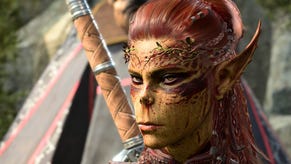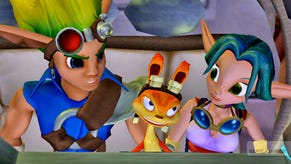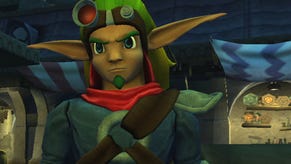The Jak and Daxter Trilogy Review
Jak-knifed juggernaut.
In many ways, the Jak and Daxter series serves as a chronicle of the declining platformer. Naughty Dog's PlayStation 2 trilogy starts off with an innocent collect-a-thon about a boy and his furry friend saving the world, but quickly shifts to a darker tone with an industrial setting, plenty of gunplay and an over-world that shows a much stronger likeness to Grand Theft Auto than the Precursor Legacy. The grim, later Jak games relegated most of their platforming to isolated tombs, ruins and ancient temples, signifying the genre becoming something of a relic.
As far as this HD upgrade for PS3 goes, it's a solid conversion with virtually no new content aside from trophies and 3D support. For the most part, developer Mass Media Inc's reverence for Naughty Dog's originals works, but it would have been nice for them to add an option for subtitles in the first Jak and Daxter, or implement separate controls for first- and third-person aiming, as what's inverted in one perspective won't be in another. Regardless of the lack of bells and whistles, remastering these games in 720p is still a significant visual upgrade of three of the most interesting platformers of the 21st century.
Jak and Daxter: The Precursor Legacy
Of all the games in this collection, Jak and Daxter: The Precursor Legacy shows its age the most - not just in terms of visuals (though its blocky character models do that), but in its design. This humble origin story hails from the days when platforming protagonists were expected to collect doodads and little else. They certainly didn't talk, and Jak instead expresses himself through dance, as was customary for the time.
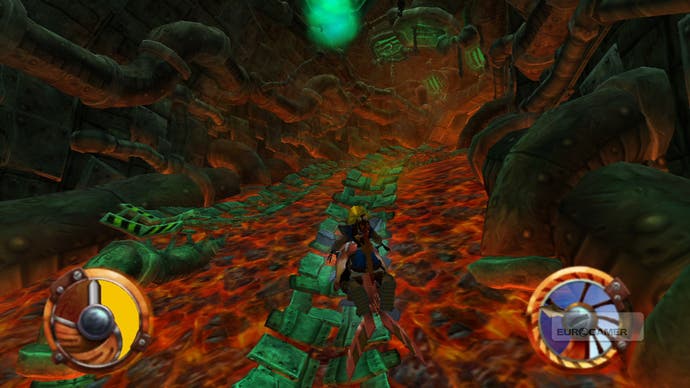
While the aesthetics are dated, there is a charm to its vibrant environments, which recall the heyday of Naughty Dog's Crash Bandicoot as well as Rare's Banjo Kazooie. Everything is a little too colourful, but this works in the game's favour as it looks playful and inviting, though the character design is generally unappealing. Jak and his goat-people brethren look a bit off-putting, like the Gelflings in The Dark Crystal, whereas the hyper-adorable Daxter is frequently mocked for being ugly. It's like that Twilight Zone episode where all the people are half-pigs and the beautiful woman is considered hideous.
The Precursor Legacy isn't terribly complex, but it manages to make what could be systematic scouring of environments enjoyable with a host of novel touches that gives its seamless landscape a cohesive, organic feel. Help a fisherman haul in his quota and he'll give you access to his boat back at the village dock. Tinker around an ancient temple and you can activate a generator that powers plates throughout the neighbouring territories, granting access to new parts of the map.
Though the interconnected level design with no loading separates it from other platformers of its time, polishing off the last few collectible scraps in any given level can turn laborious. What was great for 2001 is still pleasant enough, but it's hardly a compelling argument that things were better back in the day.
Jak 2: Renegade
The old adage "if it ain't broke, don't fix it" clearly doesn't apply to the developers at Naughty Dog. After the critical and commercial success of Jak and Daxter they could have easily reiterated that formula, but instead they daringly pressed ahead, choosing to throw the baby out with the bathwater.
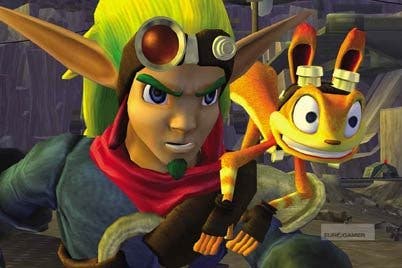
Jak 2: Renegade - or as I like to call it, Jak 2: Jak in the City - transplants the hopping hero and his fluffy orange chum to a dystopian metropolis. Gone is the affable, pantomiming protagonist of yesteryear. Instead we get a gruff-voiced, goateed, gun-wielding warrior. Luckily, the angsty streak doesn't last long, as Jak is still prone to pal around with Daxter. These two divergent personalities never quite mesh in a way that feels natural, though.
While he still leaps around some, Jak's old skills aren't enough to cut it in the hustle and bustle of modern times. He's now added driving, shooting and skateboarding to his repertoire. Naughty Dog wisely milks these diverse gameplay scenarios to their full potential, making Jak 2 one of the most varied games ever conceived.
One moment you'll be zipping around town on a hovercraft with Johnny Law hot on your six, and the next using your arsenal of firearms to evaporate hordes of feral creatures or enemy soldiers. Then it's time to race, perform tricks on your Back to the Future 2-style hoverboard, play a variation of Whack-A-Mole, transport prisoners around, or occasionally scale trap-ridden temples like the Jak of yesteryear. Areas are often revisited, but they reinvent themselves each time. The first mission in the sewers leads to a bug hunt, but the following visit turns into a hoverboard-based obstacle course. This reluctance to make the player do any one thing for more than 20 minutes guarantees a brisk pace throughout the surprisingly lengthy campaign.
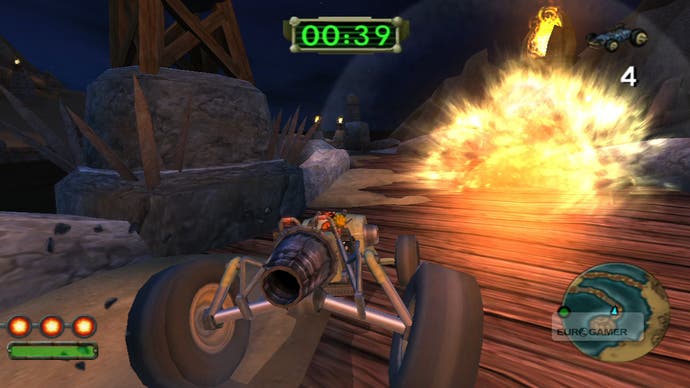
While Jak 2's restless zeal is surpassed only by its sequel, there are some ways in which it hasn't aged so well. For one, it is an extraordinarily difficult game, with checkpointing that could generously be called cruel. The lack of any kind of manual aim also feels dated, as all shooting leaves you at the mercy of the game's auto-aim. It's functional, but a little more precision would be appreciated. Elsewhere, the over-world bears a strong resemblance to Grand Theft Auto, with Jak haplessly tossing civilians out of their hovercrafts to zip around the colossal Haven City. Unlike GTA, only a handful of the actual missions take place in this hub, making it an extraordinary backdrop built almost entirely for show. It was a noble effort that adds ambiance and character to the world and connects the various stages, but Jak 2 clearly hails from an era when game designers mistakenly thought bigger was better.
Though the HD upgrade helps, time hasn't been kind to Jak 2's graphics. It pushed the PS2 to its limits, but what was showstopping eight years ago is garish today. There's a moment where our heroes find themselves crossing a bridge suspended high in the air, overlooking the city in all its glory. It should be an awe-inspiring sight, but the chunky, nondescript polygons make it look like a model. Compare this to a similar scene where Batman gazes upon Arkham City from Wonder Tower; it's shocking how far we've come in the last eight years.
Despite a few glaring concessions to its age, Jak 2 remains a joy to play and feels like a dozen games rolled into one. Not all are winners (the mandatory races continue to draw my ire), but those with the patience to looks past its sadistic difficulty, poor checkpointing and overly ambitious set-pieces will find that Jak 2 is more than the sum of its parts. A Jak of all trades, if you will.
Jak 3
Initially, Jak 3 is less Grand Theft Auto than Grand Theft Kangaroo, with our heroes galloping their way across a Flinstones-style village on squawking, half-lizard, half-marsupial creatures called Leapers. This peculiar scenario is at once familiar, yet different; a sign of Jak 3 evolving its predecessor's madcap sensibilities. (On a side note: riding a Leaper might be the finest implementation of rumble I've experienced, with the vibrating controller mimicking their every flap and waddle.)
Having already explored riffs on GTA, Tony Hawk and any number of racing games in Jak 2, Jak 3's major contribution to the series is the addition of an enormous desert wasteland which functions as a playground for vehicular combat. Taking out a series of armed dune buggies, you'll have to fend off raiders, chase down artefacts in timed challenges, and eventually take down the penultimate boss in an epic, kilometre-spanning struggle that can hold its own against anything in Shadow of the Colossus. Rather than stop there, Naughty Dog further cranks up the "What If?" machine by tossing in variations on Tempest, Pac-Man and Smash TV for no apparent reason other than it's fun. So why not?
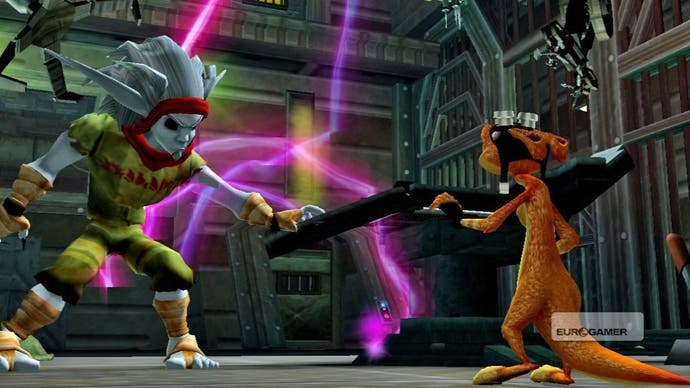
Jak 3 doesn't simply throw everything at the wall to see what sticks; it also carefully addresses most of its forebear's mistakes. Just as Grand Theft Auto 4 and Zelda: Twilight Princess scaled back their predecessors' outlandishly open worlds, Jak 3's urban sprawl is a more condensed rendition of what we saw in Jak 2. The city is now a war zone, with corrupt guards, resistance fighters and monstrous reptiles duking it out, making it a more exciting place to traverse. The riotous streets also minimise traffic, so cruising around town is much less of a hassle - and Jak 3's sensible checkpoints make the difficulty far more palatable for mere mortals, ensuring this rousing final act zooms along.
Where the first Jak game was light-hearted and goofy and the second was tonally inconsistent between its grizzled protagonist and comic sidekick, Jak 3 strikes a delicate balance. The vastly more entertaining Daxter frequently takes centre stage and some late-game plot twists are just plain silly. Jak can also kill innocent civilians, who inexplicably turn into ammo with no repercussions, which might suggest a campier title - yet there's a genuine feeling of loss that comes from revisiting old locales that now lie in ruins. The final handful of missions are as thrilling and bombastic a climax as one could hope for, bringing this fine adventure trilogy to a close.
The Jak and Daxter series may not be as solid a platformer as Sly Cooper and its gunplay isn't as refined as Ratchet & Clank's - but in terms of ambition, invention and grandiosity, it remains leagues above its last-gen platforming brethren.
In the last several years, Naughty Dog has strayed even further from its platforming roots with Uncharted's automated climbing and jumping, making it no more a platformer than heating up a dish in the microwave is cooking. The Jak and Daxter series remains a fascinating document of the evolution of the action adventure; its heroes are unstuck in time, without a genre to call home. No series has been so willing to switch gameplay styles with such reckless abandon, and The Jak and Daxter Trilogy represents a shining example of what happens when a capable developer takes a huge risk. There's nothing else quite like it.


